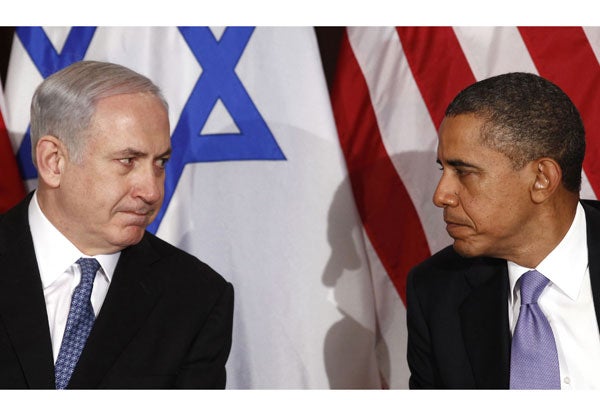Distinctly Different Approaches at the U.N.: Obama and Netanyahu on Iran
Amanda Williams /
A nuclear-armed Iran was a key topic of discussion at the U.N. General Assembly this week, including speeches by Israeli Prime Minister Benjamin Netanyahu and President Barack Obama.
While both leaders agreed that “a nuclear-armed Iran is not a challenge that can be contained,” there are key differences in approaching this issue. The following statements made by each leader outline their differences and provide insight into future debates on Iran policy.
Obama:
- “America wants to resolve this issue through diplomacy, and we believe that there is still time and space to do so. But that time is not unlimited.”
- “Make no mistake, a nuclear-armed Iran is not a challenge that can be contained.”
- “We respect the rights of nations to access peaceful nuclear power, but one of the purposes of the United Nations is to see that we harness that power for peace.”
- “That’s why the United States will do what we must to prevent Iran from obtaining a nuclear weapon.”
Netanyahu:
- “For nearly a decade, the international community has tried to stop the Iranian nuclear program with diplomacy. Well, that hasn’t worked. Iran uses diplomatic negotiations as a means to buy time to advance its nuclear program.”
- “At this late hour, there is only one way to peacefully prevent Iran from getting atomic bombs and that’s by placing a clear red line on Iran’s nuclear weapons program. Red lines don’t lead to war; red lines prevent war.”
- “Intelligence agencies are not foolproof. Do not wait to risk the security of the world on the assumption that intelligence will know when they get the bomb.”
- “Nothing could imperil our common future more than the arming of Iran with nuclear weapons. To understand what the world would be like with a nuclear armed Iran, just imagine the world with a nuclear-armed al-Qaeda.”
- “A red line must be drawn first and foremost in one vital part of their program: on Iran’s efforts to enrich uranium.”
- “The red line must be drawn on Iran’s nuclear enrichment program because these enrichment facilities are the only nuclear installations that we can definitely see and credibly target.”
Both Obama and Netanyahu stated the need for imposing limitations on Iran’s nuclear program. Netanyahu said he believes that Iran’s efforts to enrich uranium must be stopped soon, before outside powers lose the option of launching an effective strike at the uranium enrichment facilities, which are the elements of the nuclear weapons program that are most vulnerable to a military attack. While Obama stressed the idea that a diplomatic solution is still possible, Netanyahu noted that diplomacy has not worked with Iran during the past 10 years, implying that diplomacy alone will not work in the future.
Obama proclaimed that the “United States will do what we must to prevent Iran from obtaining a nuclear weapon.” But Netanyahu stressed the need to stop Iran before it gained the capabilities needed to build a nuclear weapon and urged that a clear “red line” should be set to deter the Iranian government from completing its nuclear project.
Although the two allies agree on the goal of halting Iran’s nuclear weapons program, they disagree on the best tactics for accomplishing this goal. Netanyahu displays a greater sense of urgency in using the military option if diplomacy fails. This could eventually lead Israel to go it alone and take independent military action.
For more on differences between Obama and Netanyahu on the Iran nuclear issue, see Safeguarding Israel’s Security in a Volatile Region.
Amanda Williams is currently a member of the Young Leaders Program at The Heritage Foundation. For more information on interning at Heritage, please visit: http://www.heritage.org/about/departments/ylp.cfm

